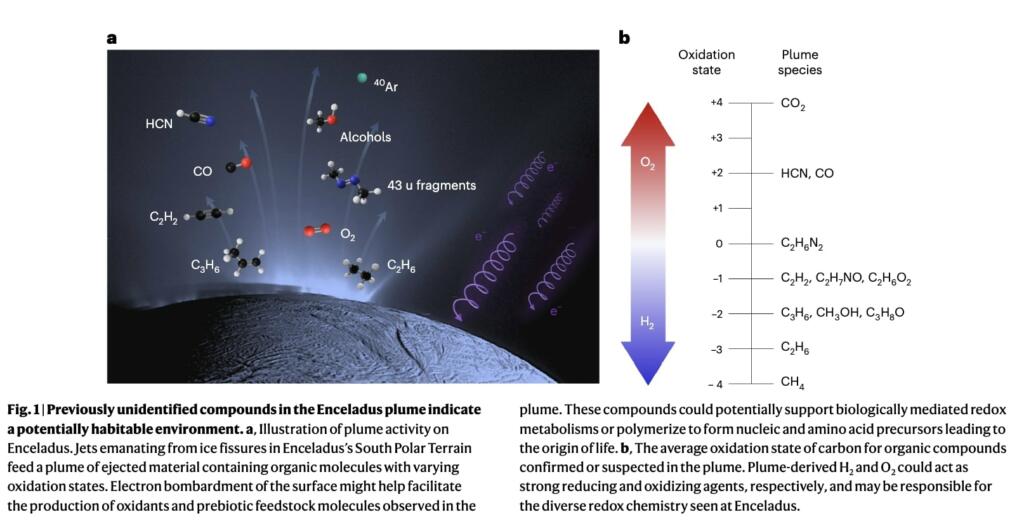Analysis of the Cassini probe data shows evidence for Enceladus habitability a step further. They’ve found strong confirmation of hydrogen cyanide, a molecule that is key to the origin of life.
The ocean below the ice of Saturn’s moon holds a powerful source of chemical energy. Unidentified until now, the energy source is in the form of several organic compounds, some of which, on Earth, serve as fuel for organisms. The more energy available, the more likely that life might proliferate and be sustained.
Odds Are High Enceladus Has Microbial Life In Its Liquid Ocean
Enceladus has a multiphasic and compositionally diverse chemical environment that is consistent with a habitable subsurface ocean. The species identified in this work also suggest that this ocean may contain the necessary building blocks required to synthesize compounds important to the origin of life.
Nextbigfuture thinks that, eventually, it will likely be proven that IF you have liquid water anywhere in space then it will be filled with at least microbial life. IF the water is liquid then there will be the energy to get the life supporting chemicals to support a biome (bacterial environment).
There are at least eight other locations in the solar system with liquid water. The other eight have liquid oceans underneath a lot of ice on moons and asteroids. The most common way to find liquid water in space is under a lot of ice.

Lead author Jonah Peter, a doctoral student at Harvard University who performed much of the research while working at NASA’s Jet Propulsion Laboratory in Southern California. “Not only does Enceladus seem to meet the basic requirements for habitability, we now have an idea about how complex biomolecules could form there, and what sort of chemical pathways might be involved.”
The detections of partially oxidized hydrocarbons along with the very likely detections of an alcohol and molecular O2 are particularly interesting as these species potentially imply a diverse redox environment within the ocean.
Nature – Detection of HCN and diverse redox chemistry in the plume of Enceladus
The Cassini spacecraft observed that Saturn’s moon Enceladus has a series of jets erupting from its South Polar Terrain. Previous studies of in situ data collected by Cassini’s Ion and Neutral Mass Spectrometer (INMS) have identified H2O, CO2, CH4, NH3 and H2 within the plume of ejected material. Identification of minor species in the plume remains an ongoing challenge, owing to the large number of possible combinations that can be used to fit the INMS data. Here we present the detection of several additional compounds of strong importance to the habitability of Enceladus, including HCN, C2H2, C3H6 and C2H6. Our analyses of the low-velocity INMS data, coupled with our detailed statistical framework, enable discrimination between previously ambiguous species in the plume by alleviating the effects of high-dimensional model fitting. Together with plausible mineralogical catalysts and redox gradients derived from surface radiolysis, these compounds could potentially support extant microbial communities or drive complex organic synthesis leading to the origin of life

Brian Wang is a Futurist Thought Leader and a popular Science blogger with 1 million readers per month. His blog Nextbigfuture.com is ranked #1 Science News Blog. It covers many disruptive technology and trends including Space, Robotics, Artificial Intelligence, Medicine, Anti-aging Biotechnology, and Nanotechnology.
Known for identifying cutting edge technologies, he is currently a Co-Founder of a startup and fundraiser for high potential early-stage companies. He is the Head of Research for Allocations for deep technology investments and an Angel Investor at Space Angels.
A frequent speaker at corporations, he has been a TEDx speaker, a Singularity University speaker and guest at numerous interviews for radio and podcasts. He is open to public speaking and advising engagements.


Wild chemistry going on under all that cold-crete. Life finding wildly different solutions to wildly different problems.
I could almost believe a coalition of pharmaceutical companies could pay for a series of sample returns, and find enough new stuff to turn a profit.
I wonder how much organic gas gets trapped in concavities under the ice? Bubbles that stretch for miles; ice ceiling hundreds of feet overhead?
Atmospheric islands with high pressure, thick “air” and low gravity.
Easier air to fly in than here at home.